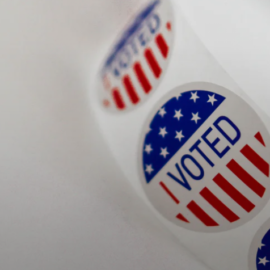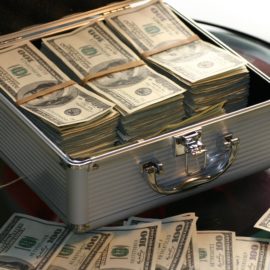

This article is an excerpt from the Shortform summary of "The Smartest Guys in the Room" by Bethany McLean and Peter Elkind. Shortform has the world's best summaries of books you should be reading.
Like this article? Sign up for a free trial here .
How did Enron get caught? And what happened when they did?
The question “how did Enron get caught” is a fraught one, partly because much of what Enron did wasn’t technically illegal. To understand how Enron got caught, you need to consider their market manipulations and the way they prioritized appearances over actual profits.
Concerns Mount Over Enron
So, how did Enron get caught? There started to be mounting external and internal concern about the reality of the losses.
By spring 2000, the dotcom bull market was over. Analysts were now questioning business plans and looking for fundamental cashflow and revenue. Momentum investors were selling instead of buying.
- Stories ran about how energy companies used mark-to-market accounting, and no outsider knew the assumptions they used to book earnings.
- Short sellers were gaining credibility and wielding larger sticks. Investor Chanos was skeptical Enron’s broadband business could be doing so well when the rest of the industry was getting slaughtered.
More negative signs cast doubt on Enron:
- Unclear disclosures about dealings with a related party
- Lay and Skilling were selling shares
- Debt was climbing when Enron was supposed to be profitable
- No one could explain how Enron made money
- Redeployments/layoffs were happening at the broadband business.
- In April 2001, on an earnings call, Skilling famously called a skeptical short-seller an “asshole” for saying Enron was the only firm who couldn’t release a balance sheet or cashflow statement. Said a stunned analyst, “any CEO should be able to handle the hardest of questions from the most aggressive of shorts.”
In February 2001, an Enron accountant, Wanda Curry, saw that EES (the retail division) had over-optimistic valuations of deals and bad trades that, on inspection, actually put the division in the red by $500MM. These number mismatches are an important part of the question “how did Enron get caught?”
- Enron’s solution was to merge the trading losses with the wholesale traders’ profits, eking out a mild profit in total. However, Enron didn’t properly report the combination of the two.
In March 2001, this book’s author (Bethany McLean) published a landmark article, “Is Enron Overpriced”, which showed the public that professional analysts had no idea how Enron made money.
In May 2001, a researcher wrote a paper deconstructing Enron’s cash flow. Of Enron’s reported $4.8 billion in operating cash flow, $2 billion was from customer deposits (which would be paid back if energy prices fell); $1 billion was from a onetime sale of inventory, and another $1.5 billion was the result of prepay. This showed a dramatically different story than the idea that Enron’s cash flow was stable and recurring.
In July 2001, internal concern over LJM’s dealings with Enron prompted Fastow to sell his interest in the LJM funds to Michael Kopper, who left Enron to take over.
Even employees started questioning Skilling publicly: “You say we’re going to make half a billion a year. What’s your strategy?” Skilling replied: “that’s what you guys are for.” This lack of accountability was a huge part of how Enron got caught.
The Dominoes Start to Fall
As a result, Enron’s stock price fell dramatically: from a height of $82 after their investor conference in Jan 2001, down to $68.50 in Feb 28 and $55 in March 21.
- Even in July 2001, when Skilling announced Enron had beaten earnings per share, share prices didn’t budge. The market had become too skeptical.
In August 2001, Skilling resigned as CEO.
- Reasons: The pressures of maintaining a rosy public facade while dealing with internal turmoil ate at him. For someone obsessed with the stock price, its decline represented a personal failure. He hated getting his hands dirty, and his job was now about fixing problems.
- Skilling’s resignation fueled suspicion that something was wrong inside Enron.
Ken Lay returned to a hero’s welcome, like the company’s savior. But having been a non-operator for years, he wasn’t helpful.
- He announced a onetime options grant of 5% of salary. The stock was at the bottom of the cycle, and “we want you to enjoy the ride back up.” The stock was at $38.
- He announced Greg Whalley, head of wholesale trading, as COO. Whalley quickly dug in and pressed for clear financials.
- Tidbit: Ken Lay himself was paying off creditors. Despite having a net worth at its peak in the 9 digits, he had “diversified” by taking out loans with Enron stock as collateral, and with terms to face margin calls at lower Enron stock prices. The loans were then put into ill-fated investments.
Here was the nightmare dominoes scenario – where all the intricately connected layers would fail because of their dependencies, answering the question “how did Enron get caught?”
- If Enron missed earnings, its stock price would fall.
- If its stock fell, its SPE deals would unwind (since they were predicated on Enron stock prices rising), causing Enron to have to book massive debt on its balance sheet or issue new shares. This would cause further stock price falls.
- This increased debt would cause a downgrade of Enron’s creditworthiness.
- This would trigger provisions in Enron’s debt agreements to pay back loans early, and trading partners to demand cash collateral.
- Since Enron didn’t actually have cash, its ability to pay would progressively worsen, causing it to go bankrupt.
- Senior managers predicted the likelihood of this at less than 25%.
Enron’s Final Moments
The nightmare scenario is more or less what happened at the end of 2001. Over a series of months, Enron collapsed, one step after another.
On Wednesday November 28, the rating agencies cut Enron into junk territory.
- This triggered $3.9 billion in debt.
- Dynegy officially canceled the deal.
- Enron Online shut down. Shares dropped to $0.61
Banks moved to minimize their losses, asking for return of collateral. Enron didn’t have it.
On Sunday, December 2, Enron filed for bankruptcy.
The Legal Aftermath and Enron’s Legacy
As the largest bankruptcy in US history to that point, the public demanded heads. And there were many responsible parties to punish.
The clearly illegal smoking guns led to straightforward convictions – Fastow’s misrepresentations about LJM; asset sales that were booked as revenue but in reality had a guarantee to be rebought, which meant it was a loan. This was a simple explanation of how Enron got caught.
But how did Enron get caught in other departments? Arthur Andersen, previously one of the big five accounting firms, was convicted of obstruction of justice in 2002 for shredding documents. It voluntarily surrendered its licenses to practice as CPAs in 2002.
- (The Supreme Court later reversed the conviction in 2005, though by that point its besmirched reputation prevented it from gaining any clients.)
The banks agreed to write big settlement checks, ultimately producing $7.2 billion for shareholders (about 20 cents for each dollar lost).
Beyond these, the legal difficulty was that most of the financial maneuvers were not technically illegal (which is why Fastow so brazenly boasted about the structures, and Wall Street praised them).
So, how did Enron get caught exactly? Through a combination of business failures and public relations problems, the true nature of Enron came to light. So if someone asks you “how did Enron get caught” you know the complete answer.

———End of Preview———
Like what you just read? Read the rest of the world's best summary of Bethany McLean and Peter Elkind's "The Smartest Guys in the Room" at Shortform .
Here's what you'll find in our full The Smartest Guys in the Room summary :
- How Enron rose to become one of the world's most promising companies
- How Enron management's greed led it to start cutting corners
- The critical failures that crashed Enron's house of cards to the ground






